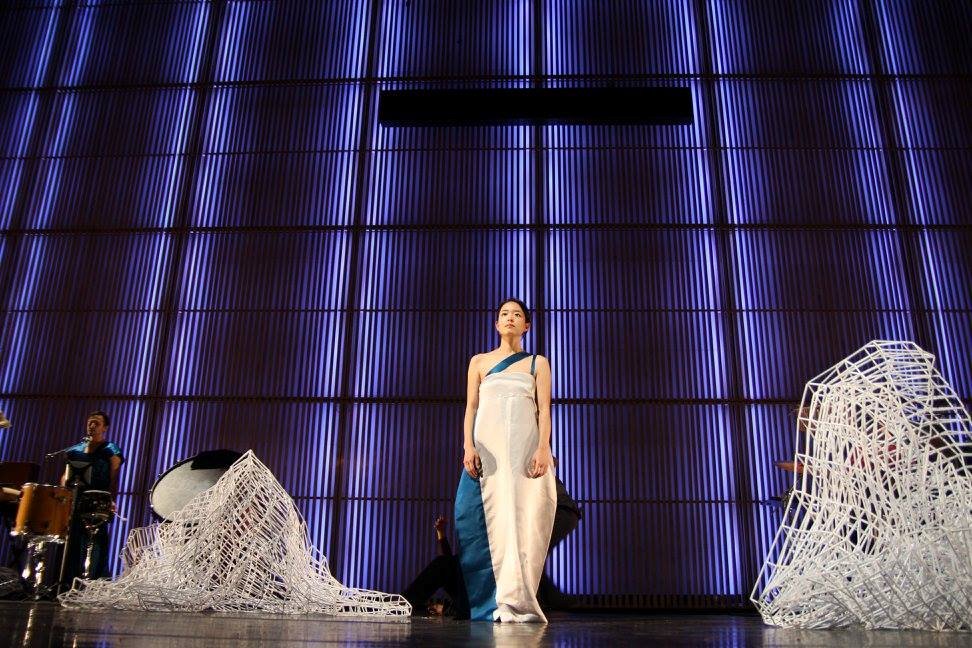After the world premiere of Words & Beyond II: Nan Sul Hun by Seung-Won Oh yesterday at the Muziekgebouw aan 't IJ, the audience stood up as one to cheer Slagwerk Den Haag and the soloists. It was therefore a magical performance, which will be repeated at De Doelen in Rotterdam and at Theater aan de Parade in Den Bosch. Four reasons to go there.
1. The story
Korean/Dutch Seung-Won Oh (b 1969) drew inspiration from the tragic life of Korean poet Nan Sul Hun. Born in 1563 into an aristocratic family of the Chosun dynasty, she was called Cho-Hee. Although this means little more than 'child of the Cho family', this was exceptional, as girls were often only named as 'the fifth child'. She was also encouraged in her parental home to develop her talents: from a very young age, she wrote high-quality poetry.
Her free life changed drastically when she was married off at 15, as usual. Her newlywed husband regarded women as inferior and refused to treat her as his equal. She could not communicate with the rest of her in-laws on her own level either, and Cho-Hee ended up in social isolation. This became all the more distressing when she lost her brother and two of her children in a short period of time.
Cho-Hee retreated to her own room, from which she looked wistfully out over the garden and mountains. She contained her loneliness, longings and lack of love in highly expressive, personal poems. 'She found friendship in her poetry,' Seung-Won-Ah Oh said of this in a conversation I conducted with her for musicvan.nu. (This website was discontinued in 2015).
Nature also offered some consolation: in her verses, for instance, Cho-Hee sings of the beauty of an orchid and the virginal innocence of snowflakes. Finally, she self-consciously chooses her own name: Nan Sul Hun - orchid, snow, house. She dies at 27, as she predicted in a poem, but lived on thanks to her poetry and is considered one of Asia's first bestselling authors.
2. The music
Seung-Won Oh initially composed according to the prevailing avant-garde, atonal idiom. It was only when she came to the Netherlands for postgraduate studies with Louis Andriessen that she went in search of her roots. 'He asked me about what I actually wanted to tell myself,' she said about this yesterday during the introduction. Korean traditional music turned out to be a goldmine and Seung-Won-Ah Oh started incorporating elements from it into her own work. In the above-mentioned interview, she stressed that she did not want to use superficial features, such as the use of pentatonic scales (five notes, without semitone distances), but instead wanted to get to the essence of this music.
This is in the extreme refinement and microtonal inflections between the notes of a melody. In Words & Beyond II: Nan Sul Hun we can hear them not only thanks to a komungo, a Korean zither, but also in Chong-Ga, the traditional chant of the Korean aristocracy. Min-Hee Park kept us breathless with extremely elongated notes, reaching straight to heaven in their purity and varied timbres. Also special was her effortless switching from a deeply buzzing low register to the most rarefied heights. Less exciting were the moments when Seung-Won-Ah Oh mouthed her 'western' melodies.

3. The staging
Seung-Won Oh aims for a form of total theatre and asked Korean/American Jinnie Seo to handle the design. Seo designed not only the beautiful stage image but also the costumes of both singer, dancers, and musicians. On stage are several sculptures of plastic wires woven together in rocky shapes, and on the back wall we see a shadow play of two dancers. Thanks in part to Ria Marks' subtle direction, a great unity of music, image, light and dance is created, all the more so as the musicians also behave like actors. It is striking how much silence Seung-Won-Ah Oh includes in her score, giving the sounds great impact and every opportunity to reach the smallest corners of the auditorium.
4. The implementation
Although this was a world premiere and not all the musical material had yet found its proper place, the performance was enchanting. The percussionists of Slagwerk Den Haag, accordionist Marieke Grotenhuis and komungo player Soo-In Son made music in supreme concentration and - without the help of a conductor - managed to get their often tricky timing spot on. The young dancers Yann Dorsaz and Frederik Kaijser showed themselves to be masters of ultra-rare hushed movements as well as more aggressive, wild leaps.
Min-Hee Park made a deep impression with her Chong-Ga singing and by the dignified way she strutted across the stage. But despite the great concentration of all the performers, the performance did slump a little at two-thirds, at what really should have been the climax. Right at the moment when Cho-Hee chooses her own name in an English-language monologue, the surtitles dropped out. Because Park's English left something to be desired, we often had to guess at what she was saying. Words & Beyond II: Nan Sul Hun is still a work in progress and no doubt both of these shortcomings will be fixed in upcoming performances.
Seung-Won Oh Words & Beyond II: Nan Sul Hun
Muziekgebouw aan 't IJ 29 October 20:15 (world premiere)
De Doelen, 3 November 8.15pm
Theatre aan de Parade, 8 November 21.00 (November Music)
Percussion The Hague
Ria Marks, direction Jinnie Seo, set, installation, costumes Kenzo Kusuda, choreography Stefan Dijkman, lighting design Jerry Williams, translations and dramaturgy Min-Hee Park, Chong-Ga vocals Marieke Grootenhuis, accordion Soo-In Son, komungo Yann Dorsaz, Frederik Kaijser, dance
